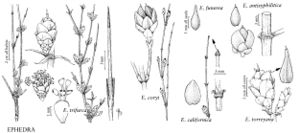Ephedra coryi
Bull. Torrey Bot. Club 63: 351. 1936.
Shrubs rhizomatous, forming clumps, erect, 0.25–1.5 m, 3–5 m diam. Bark redbrown, cracked and irregularly fissured. Branches alternate or whorled, becoming rigid, angle of divergence about 25°. Twigs bright green, becoming yellow-green with age, not viscid, ridges between longitudinal grooves papillate, slightly scabrous; internodes 2–5 cm. Terminal buds conic, 1–3 mm. Leaves opposite, 2–5 mm, connate to 1/2–3/4 their length; bases thickened, brown, persistent, becoming hard, enlarged, and black; apex acute. Pollen cones 2–several at node, obovoid, 4–6 mm, on very short, scaly peduncles (rarely sessile); bracts opposite, 5–9 pairs, light yellow, ovate, 2–4 × 2–3 mm, membranous, slightly connate at base; bracteoles slightly exceeding bracts; sporangiophores 2–4 mm, 1/4 exserted, with 5–7 sessile to short-stalked (less than 1 mm) microsporangia. Seed-cones 2–several at node, obovoid to nearly globose, 7–15 mm, on smooth peduncles, 5–25 mm, with 1 pair of basal and 1 pair of nearly terminal bracts, at least in early cones; bracts opposite, 3–4 pairs, ovate to circular, 5–8 × 5–12 mm, inner pairs becoming fleshy (at least centrally) and orange at maturity. Seeds 2, ellipsoid, 5–8 × 2–4 mm, brown to chestnut, smooth.
Phenology: Coning March–April.
Habitat: Sandy, semiarid areas
Elevation: 500–2300 m
Discussion
In New Mexico Ephedra coryi occurs only in an isolated population in the San Andreas Mountains and represents the shorter extreme (5–10 mm) in the range of peduncle length.
Selected References
None.
Lower Taxa
"/2-3/4" is not declared as a valid unit of measurement for this property.

